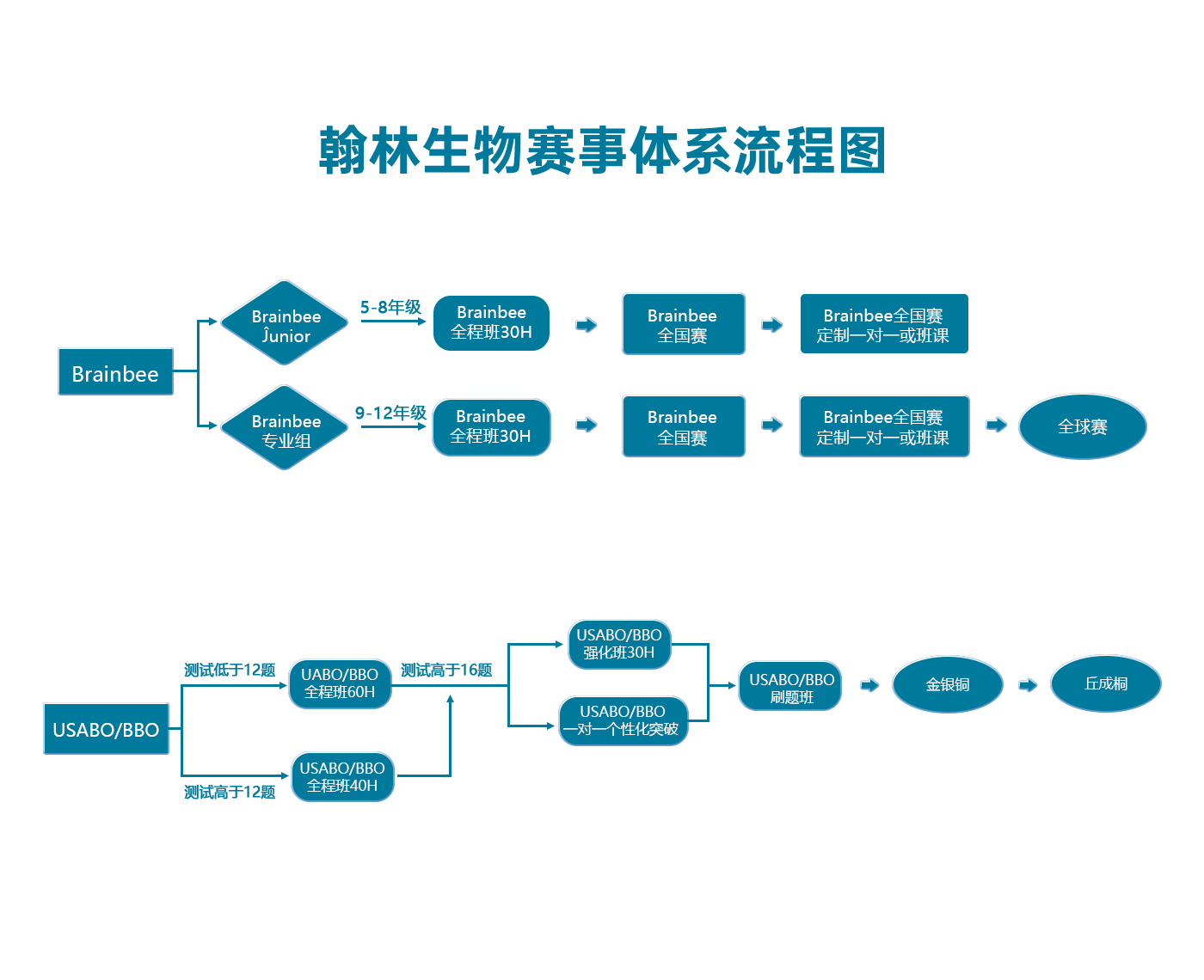- 翰林提供学术活动、国际课程、科研项目一站式留学背景提升服务!
- 400 888 0080
2021bbo考题深度分析及2022年考点预测来了!
春暖花开,又到了每年BBO/USABO考试的季节,大家的辛苦备考也到了最后的冲刺阶段,为了帮助各位考生充分利用这最后的一周时间,我们分析一下2021bbo考题,希望能够帮助大家理清思路,轻松迎战,考出理想的成绩。
赛事简介
英国中学生物奥林匹克 (British Biology Olympiad,简称 BBO),该比赛由英国皇家生物学(简称 RSB)会主办,是英国中学历史最长、影响最大的理科活动之一,每年英国有近万名高中生参与。
我们知道BBO和USABO的考试大纲是一样的,考察的内容和所占的分值比例分别为:
Animal anotomy & Physiology(25%)
Cell Biology (20%)
Genetics & Evolution (20%)
Plant Anatomy & Physiology (15%)
Ecology、Ethology & Biosystematics (20%)
下面我们就对2021年BBO考题在这5大部分里面构成的情况和具体考察内容进行逐一分析:
考题分析
01.Animal anotomy & Physiology
Q2 Part 1-8 5分,Q8 Part1-5 10分,共计15分。占比17%以上
Q2主要考察了免疫系统的humoral response 和cell-mediated response,抗原与抗体的结合。同时也考察了学生对通路(Pathway)和限速蛋白的理解,相关概念我们在课程里酶的章节有过详细讲解。Q8 考察了新冠疫苗开发的原理以及如何进行疫苗有效率的计算,也是我们课程里面讲过的内容,先特将疫苗有效率的计算公式分享给没有上过课的同学:
02.Cell Biology
Q6 Part 1-8 5分,Q7 Part1-7 8分,共计13分。占15%
Q6 以penicillin这个抗生素为例,考察学生对化学结构决定功能这一规律的理解以及对蛋白质活性、酶竞争性抑制、反馈调节、酶催化效率等细胞生物学基础知识掌握的程度。Q7以病毒为例,考察了学生对中心法则的理解以及疫苗的开发原理。这两个考点都是我们在课堂上花了大量时间讲解的内容,同学们一定要掌握。
03.Genetics & Evolution
Q3 Part 1-4 10分,Q5 Part 1-4 7分,Q10 Part 1-15 14分,共计21分。占24%
Q3考察了遗传疾病,遗传题考查主要集中在非孟德尔遗传规律的部分,要充分理解Multiple Alleles, Codominance,Pleiotropy, Epistasis, Polygenic inheritance, Linked gene and crossover, Mitochondrial inheritance, sex-linked 这些各种inheritance pattern 的原理。这一部分的内容我们已经在课堂上进行了充分的练习和讲解,同学们可以把常染色体显性遗传、常染色体隐性遗传、X染色体连锁显性遗传、X染色体连锁隐性遗传和Y染色体连锁等遗传的pattern of inheritance 记下来,对快速解题会有帮助。
Q5以baobab trees这个巨大基因组物种为切入点,考察了学生对基因组、染色体数目以及减数分裂的理解。
Q10介绍了基因比对alignment的原理,考察学生对转录、翻译等分子生物学的基础概念。以及突变和进化的分子生物学基础。
04.Plant Anatomy & Physiology
Q4 Part 1-10 9分,共计9分, 占10%
Q4考察的是学生对桃子外皮有毛和无毛的理解,这与我们讲过的植物叶片的trichomes很类似,同时也结合了遗传学的内容。
05.Ecology、Ethology & Biosystematics
Q1 Part1-13,Q9 Part1-5 14分,共计27分。占30%
Q1考察了学生对生物群体进行统计的能力,关于一个生物群体的Size、Density、Dispersion这些基本概念以及上述指标的取样测定方法同学们一定要熟练掌握。Q9以新冠病毒的英国变种为例,考察了学生对于进化的推动力和进化的规律的理解。
扫码免费领取2021bbo考题及解析,还有名师在线辅导!

考点预测
可以看到,去年的题目有大量关于人体免疫系统和病毒的内容,今年我们仍然处在新冠疫情大流行中,人体免疫系统和病毒的内容我认为任然会是今年的考试热点。
同时,20种氨基酸的化学特性及他们对蛋白质功能和结构的影响,CRISPR/Cas9转基因技术的原理,植物光合作用C4途径,神经细胞信号传导这些非常重要但是去年没有考察到的内容很有可能出现在今年的考试中。
最后,特将BBO/USABO考试的重要知识点和重点考察内容提供给大家,大家可以按照这个知识点列表,对自己的知识体系进行梳理,希望能够对大家有所帮助。
Biochemistry and macromolecules
Cell and cell cycle
Two major types of bonds (ionic bonding and Covalent bonding)
Properties of water
pH is the measure of the acidity and alkalinity
Organic compounds/ macromolecules (Carbohydrates, lipids, protein and nucleic acids)
20 amino acids chemical structure, name and three letter, one letter abbreviation
Four levels of protein structure
Prokaryotes VS. Eukaryotes
Mitochondrion
chloroplast
Surface vs volume ratio
Cell differentiation
Phases of the cell cycle
Cell cycle regulation
Energy, Metabolism and Enzymes
Cell respiration
Photosynthesis
First and second law of thermodynamics:
Free-energy change
The characteristics of enzyme
Michaelis–Menten Plot of Enzyme Kinetics
Allosteric inhibition of enzyme
Cooperativity of enzyme
Glycolysis
Pyruvate oxidation
Citric acid cycle
Oxidative phosphorylation
Substrate-level phosphorylation
Electron transfer chain
Anaerobic respiration
The light reactions
The Calvin cycle
Plant anatomy and physiology
Angiosperms and Gymnosperms
Ground tissue (Paraenchyma, Collenchyma, Sclerenchyma)
Double fertilization
Stem and root structure of Dicots and Monocots
Primary and Secondary Growth
The formation of lateral root
Simple and compound leaves
Regulation of stoma
Plant hormones
C4 plant anatomy and the C4 pathway
ABC hypothesis
Pressure flow hypothesis
Function of trichomes
The molecular basis of inheritance
genetic engineering
Central dogma
DNA replication
Semiconservative model
Chromatin Packing in a Eukaryotic Chromosome
Transcription
Translation
The initiation of transcription at a eukaryotic promoter.
The genetic code
Bacteria transformation
Polymerase chain reaction (PCR)
DNA Gel electrophoresis
CRISPR/Cas9 system in E. coli
Genetics and genetic disorder
The human life cycle.
Meiosis
Sexual reproductivity contribute to genetic variation
Mendel’s law of dominance
Law of segregation
The Testcross
The Law of Independent Assortment
Incomplete dominance
Multiple Alleles
Codominance
Pleiotropy
Epistasis
Polygenic inheritance
Linked gene and crossover
Mitochondrial inheritance
Environmental Impact and genotype interaction
Pedigree Analysis
Recessively Inherited Disorders
Dominantly Inherited Disorders
Sex-linked genes
Hardy-Weinberg Equilibrium
Human physiology I
Digestive, Respiratory, Circulatory,
Excretory system
Anatomical Terms
Body planes
Mouth
Esophagus
Stomach
Duodenum
Large intestine
The timing and location of chemical breakdown of macromolecules
Hormones that regulate the digestive system
Medulla in brain control the breath
Hemoglobin
Component of blood
Blood clotting
Structure and function of blood vessels
The human heart:
ECG, electrocardiogram
Ectotherms and Endotherms
Countercurrent heat exchange
Osmoregulation
Kidney
Nephron
Hormone control of the kidneys
Human physiology II
Endocrine, Nervous, Muscle system
Cell communication
Hypothalamus
adrenal gland
antidiuretic hormone (ADH
oxytocin
Posterior pituitary
Anterior pituitary
FSH (Follicle-stimulating hormone)
LH (Luteinizing hormone)
TSH (Thyroid-stimulating hormone)
ACTH (adrenocorticotropic hormone)
Prolactin
MSH: Melanocyte-stimulating hormone
GH: (Growth hormone): stimulate growth of bones
Differences in hormone solubility and structure
Stress and the adrenal gland.
Feedback regulation and coordination with the nervous system
The development of Brain
Reflex Arc
The role of voltage-gated ion channels in the generation of an action potential.
Conduction of an action potential
Schwann cells and the myelin sheath
Synapse
Neurotransmitters
Two mechanisms of terminating neurotransmission.
Eye
Sarcomere
Sarcoplasmic reticulum (SR)
Summation and tetanus
Contraction in a skeletal muscle fiber.
Human physiology III
Immune system and vaccine development
Primary lymphatic organs
Secondary lymphatic organs
Phagocytosis and local inflammatory response
Antigen recognition by T cells
Antigen recognition by B cells and antibodies.
Activation of a B cell in the humoral immune response
The central role of helper T cells in humoral and cell-mediated
Clonal selection
ABO blood type
Vaccine development
Calculation of vaccine efficacy
Evolution, Ecology
Preserving variation in a population
Causes of evolution of a population
Stabilizing selection
Disruptive/diversifying selection
Directional selection
Sexual selection
Artificial selection
Speciation and reproductive isolation
Allopatric and Sympatric speciation
Polyploidy
Habitat isolation
Behavioral isolation
Temporal isolation
Reproductive isolation
Linnaeus’s binomial classification
Phylogenetic trees
Patterns of evolution
divergent, convergent, parallel, coevolution, and adaption radiation evolution
analogous structures
homologous structures
Monophyletic group
Paraphyletic group
Polyphyletic group
Fundamental niche
Realized niche
Properties of population
Symbiosis
Mutualism
Commensalism
Parasitism
Amensalism
Batesian mimicry
Mullerian mimicry
Energy flow and the food chain
距离BBO正式开考还有不到一星期的时间,已经报名的同学一定要把握好冲刺的时间,在上文所提到的重点里找寻更多提分的可能!乘风破浪会有时,直挂云帆济沧海,祝大家取得好成绩!
翰林生物学术活动课程体系流程图


在线登记
最新发布
翰林课程体验,退费流程快速投诉邮箱: yuxi@linstitute.net 沪ICP备2023009024号-1








